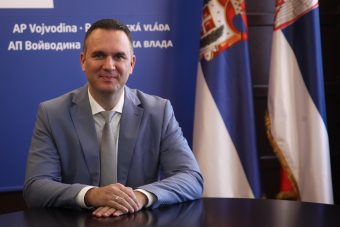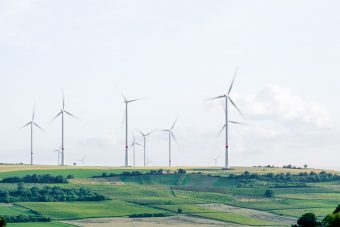
Numerous accomplished renewable energy projects (RES), as well as those that are still in their infancy, are proof of Vojvodina’s potential in this sector. We discussed with Ognjen Bjelić, the provincial secretary for energy, construction and transport, whether there is possibility for development of every type of RES on the plain, what investors can expect and what projects are currently in progress.
EP: The territory of the Autonomous Province of Vojvodina has proven to be an extremely suitable area for the development of RES projects. Out of 398 MW, 397.5 MW is in the territory under your jurisdiction, and many more gigawatts are in the process of instalment. Do you know how many permits and require- mentsthe PS has issued?
Ognjen Bjelić: The stated data of 397.5 MW refers to the installed power of wind farms built in the territory of the AP of Vojvodina. Along with it, we must not forget other sources, especially the developing biogas plants. The Provincial Secretariat issues construction permits for power plants above 10 MW and for facilities above 50 m. More than 200 different requests of RES investors have been resolved in the previous period, and it is interesting that there are many investors who are just getting ready to begin with the construction, which shows that electricity production in Vojvodina will be significantly increased.
EP: During the last few months, we have witnessed that a suspicion has been raised of the need to invest in RES, what is your position on the matter?
Ognjen Bjelić: I’d say that there is no doubt that we are in need for the investment, rather there are different views on the role of public companies and state institutions in this process. Having different opinions is a positive thing and will certainly lead to more potential solutions from which it will be possible to choose the best one for our country. There are problems and the solution certainly lies in adjusting the electric power system to the increase of the share of renewable energy sources. I believe that public companies and institutions will find a model through which the burden of that adjustment will not endanger the electricity stability of the system, which will give investors clear guidelines regarding the direction of the planned development in electricity production.
In focus:
EP: What energy potentials does Vojvodina have?
Ognjen Bjelić: The Provincial Secretariat prepared the Geothermal Atlas of Vojvodina, as well as the Study on Geothermal Potentials of Vojvodina, whilst through cooperation on the GOSPEL project, the potential places for the development of deep geothermal energy were identified. Three zones in Vojvodina offer great opportunities for heat production by exploiting geothermal fluid at a minimum temperature of 55-60 °C. When the temperature levels are sufficient, this heat may be converted into electricity. These areas include the towns of Subotica, Sremska Mitrovica and Kikinda. The first two were chosen because of the possibility of thermal energy valorisation, and the last one for the possibility of producing electricity from a geothermal source.

In the field of solar energy, a Study on the Assessment of the Total Solar Potential with a Solar Atlas has been prepared. The number of sun hours in Vojvodina ranges from slightly less than 2,000 hours (western part) to 2,100 hours (eastern part) per annum. During the following period, the Secretariat will be committed to the improvement of data at the level of micro-locations, i.e. to the development of local cadastres (or registrars) in which locations will be processed, from the aspect of solar energy, documentation planning and connection possibilities. This way, investors will be given a clear picture of the potential and profitability of the investments.
Locks on the river Tisa, as well as the sluices on the DTD Hydro system, have potential for hydropower plants’ deve- lopment, not to mention the use of crop residues and corn as biofuel, since their potential is obvious.
EP: Apart from RES projects, there is also thermal power plant Pančevo in Vojvodina. What is the significance of that infrastructure facility?
Ognjen Bjelić: Thermal power plant Pančevo is a steam-gas thermal power plant with a capacity of 200 MW that is natural gas-fired power plant. This investment is significant due to its capacity and the increase in the share of gas power plants in the power system. Gas power plants are one of the transnational solution options and currently they also serve as a support for the conventional coal – fired thermal power plants. The Provincial Government has good cooperation with the EBRD in terms of energy efficiency. Recently, a document was signed suggesting energy efficiency improvement in eighty buildings.
The Provincial Secretariat, in cooperation with the Faculty of Technical Sciences in Novi Sad, has prepared detailed energy audits for 94 facilities, concurrently with the process of drafting detailed energy audits. At the end of last year, the Assembly of Vojvodina adopted the text of Pre Financing Agreement with the European Bank for Reconstruction and Development, which defined conditions for contracting loans and implementation of energy rehabilitation projects, thus defining the framework for contracting loans and withdrawing donations. In the next month, in cooperation with the EBRD, we will start developing conceptual solutions for 80 public buildings, and upon the completion of the conceptual solutions, the procedure of selecting the contractor who will prepare the preliminary design, obtain a decision on approval for works and carry out energy rehabilitation of the facility, will commence. The manner of conducting the procedure will be proposed by the consultants, according to the procedures of the European Bank for Reconstruction and Development.
Interviewed by: Danijela Isailović
Read the story in the new issue of the Energy portal Magazine ELECTROMOBILITY.



